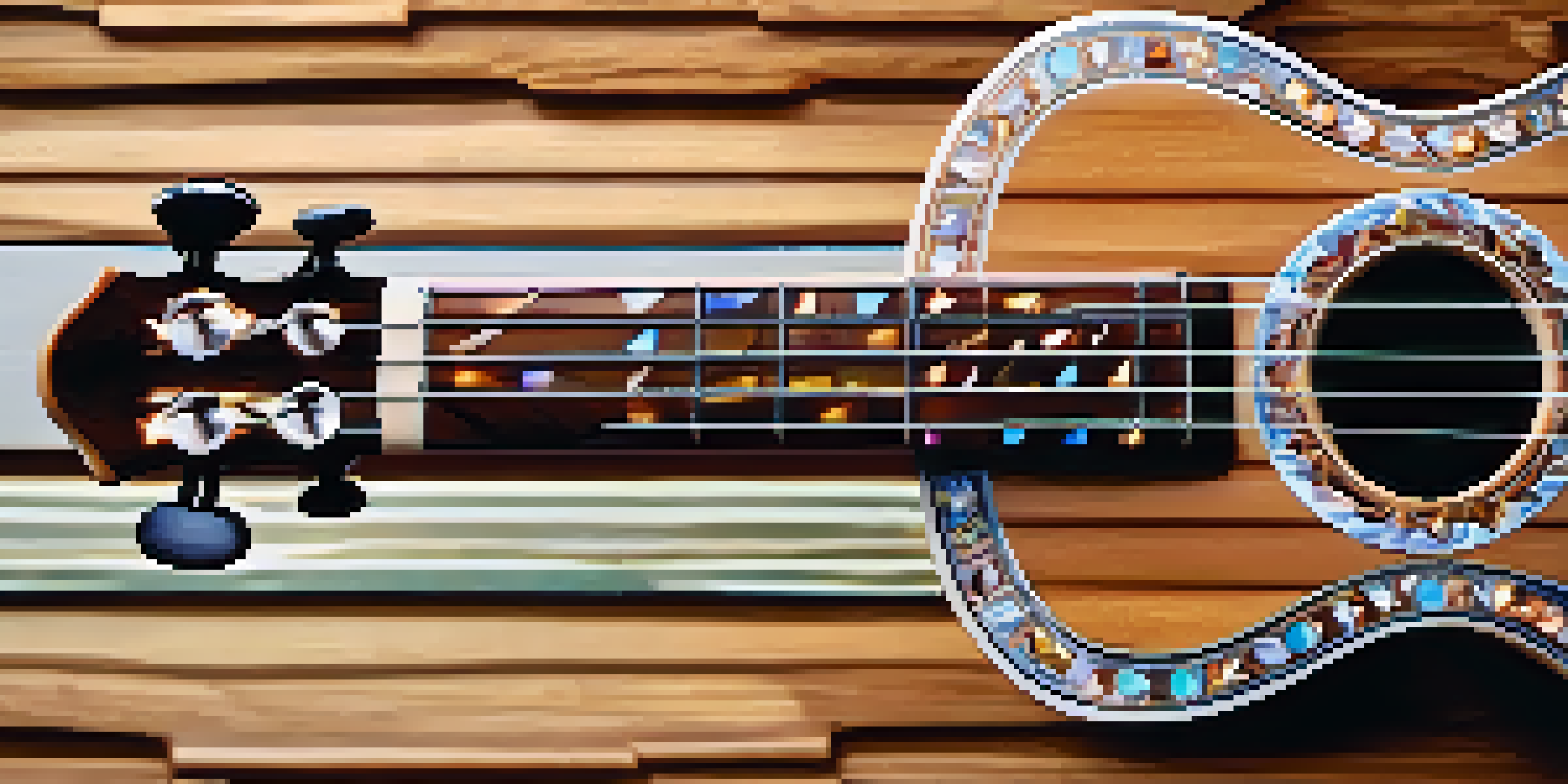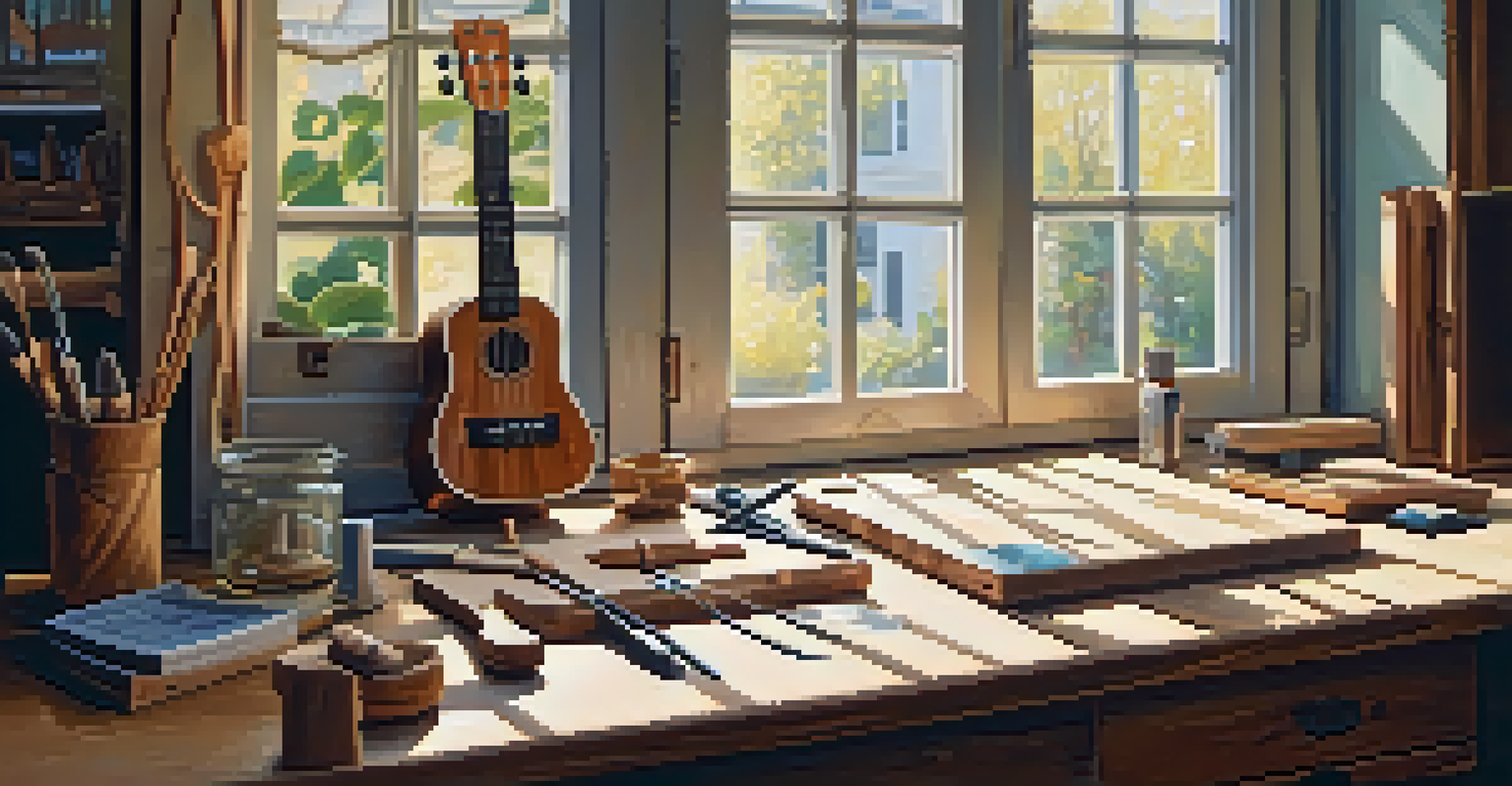Adding Custom Inlays to Your Ukulele: A Guide

Understanding Ukulele Inlays and Their Importance
Inlays on a ukulele aren’t just for decoration; they add a personal touch and can enhance the instrument's overall aesthetics. Think of them as the jewelry of the ukulele world—unique pieces that reflect your personality. Whether you’re a beginner or an experienced player, custom inlays can make your instrument feel truly yours.
Music is the shorthand of emotion.
Beyond aesthetics, inlays can also serve a functional purpose by providing visual markers for fret positions. This is especially helpful for novice players who are still getting used to the fretboard. It’s like having a friendly guide on your instrument, helping you navigate your musical journey.
Ultimately, custom inlays can transform an ordinary ukulele into a stunning visual statement. They can tell a story or represent a particular theme that resonates with you. So, let’s explore how to add these unique features to your ukulele!
Choosing the Right Materials for Your Inlays
When it comes to inlays, the materials you choose are crucial for both appearance and durability. Common materials include wood, plastic, shell, and even mother-of-pearl, each offering distinct looks and textures. For example, a shell inlay can give a beautiful iridescent effect, while wood can provide a warm, natural touch.

Consider also the thickness and flexibility of the materials you select. Some materials may require more intricate carving, while others are simpler to work with. It’s important to choose something that fits your skill level and the tools you have at hand.
Inlays Personalize Your Ukulele
Custom inlays not only enhance the aesthetics of your ukulele but also make it uniquely yours.
Lastly, think about how the inlays will complement the overall design of your ukulele. Aim for a cohesive look that reflects your style. This process is not just about aesthetics; it’s about creating a piece of art that resonates with you.
Gathering the Necessary Tools for Inlaying
Before diving into the inlay process, it’s essential to gather all the necessary tools. A good set of precision chisels, a router, and some sandpaper are key items on your list. Think of it as setting up your kitchen before cooking; having everything ready helps ensure a smoother process.
The beautiful thing about learning is that no one can take it away from you.
You might also want to invest in some adhesive that’s suitable for wood or the material you’re using. This will ensure that your inlays stay put and withstand the test of time. Using the right materials can make all the difference in the longevity and beauty of your work.
Don’t forget about protective gear, like goggles and a mask, especially when working with dust or chemicals. Keeping yourself safe while you create is just as important as the art you’re producing. Now that you’re equipped, let’s move on to the actual inlay process!
Preparing Your Ukulele for Inlay Work
Before applying any inlays, it’s crucial to prepare your ukulele properly. Start by selecting the area where you want to place the inlays. This could be on the fretboard, around the soundhole, or even along the body. Just like selecting a canvas for a painting, the right spot can enhance the overall look.
Next, you’ll need to carefully measure and mark where the inlays will go. This step requires precision, as any misalignment can throw off the entire design. Using a pencil or a fine marker helps you visualize your placement before you make permanent changes.
Choose Materials Wisely
Selecting the right materials for your inlays affects both their appearance and durability.
Finally, make sure to clean the area thoroughly to ensure good adhesion. Dust and oils can prevent the inlays from sticking properly, so a clean surface is essential. With everything prepped, you’re ready to dive into the exciting part: the inlaying!
Applying Your Custom Inlays with Precision
Now comes the fun part—actually applying your custom inlays! Start by carefully cutting out the spaces where the inlays will fit. This requires a steady hand and a lot of patience, as precision is key to achieving a professional look. Imagine it like carving a delicate sculpture; every cut matters.
Once your spaces are cut, apply a thin layer of adhesive to the area and carefully place your inlays. Press them down gently, ensuring they fit snugly. Think of this step as laying the foundation for your masterpiece; a good start will lead to impressive results.
After the inlays are in place, let the adhesive dry completely before moving on to the next steps. Rushing this process can lead to mistakes, so patience truly pays off here. While you wait, take a moment to admire your handiwork and visualize how beautiful your ukulele will look!
Sanding and Finishing Your Inlays Smoothly
Once your inlays have dried, it’s time to sand them down for a smooth finish. Use fine-grit sandpaper to gently sand the surface until it’s flush with the fretboard or body of the ukulele. This step is like polishing a gem; it brings out the beauty of your work and ensures everything feels seamless.
Be cautious during this process to avoid removing too much material. A little pressure goes a long way, and taking your time will help you achieve that pristine effect. As you sand, check frequently to ensure you’re on the right track.
Regular Maintenance is Essential
To keep your custom inlays looking fresh, regular cleaning and proper storage are crucial.
Finally, consider applying a finish or sealant to protect your inlays. This will not only enhance their appearance but also ensure they stand the test of time against wear and tear. With everything polished up, your custom ukulele is almost complete!
Maintaining Your Custom Inlays for Longevity
After all your hard work, the last thing you want is for your inlays to lose their charm. Regular maintenance is key to keeping them looking fresh. Wipe down your ukulele after each use to remove any dust or oils that may accumulate over time. Think of it as giving your instrument a gentle spa treatment!
Avoid exposing your ukulele to extreme temperatures or humidity, as these can adversely affect the materials used in your inlays. Store your ukulele in a suitable case when not in use, and consider using a humidifier in dry environments. This proactive approach will help ensure your inlays remain vibrant.

Lastly, don’t hesitate to inspect your inlays periodically for any signs of wear. If you notice anything amiss, addressing it early can prevent more significant issues down the line. With proper care, your custom inlays will continue to shine for years to come.